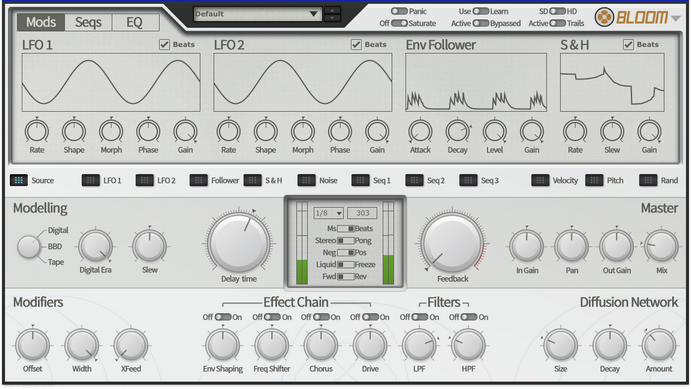Bloom is a creative delay and reverb effect with a wide range of advanced modulation functions.

Bloom Audio functions
Stereo delay line
At the heart of Bloom is a single delay line that operates in stereo. 3 delay models are available - Digital (which can be dialled between vintage dirt and modern clarity), analogue BBD (bucket-brigade delay) and Tape models. Bloom's delay models are authentic and realistic, designed to offer huge variety of rhythmic texture to your productions.
Diffusion network
Bloom's Diffusion Network provides a newly-developed algorithmic reverberation effect. Its simple-to-use controls should be familiar to you if you've ever used a reverb effect before.
It can exist in 3 different positions within the Bloom audio path - see the EQ/Routing page section for details.
Effect chain
The Effect chain provides a number of audio processing blocks which can be used to shape the sound of Bloom's output and feedback characteristics. The overdrive, filtering, saturation and dynamics functions are very useful for moulding the tone and shape of the feedback, while frequency-shifting and chorus functions are also available for psychedelic effects.
Using the EQ/Routing page the position of the Effect chain can be moved so that that it only affects the entire output of the delay line or only the feedback path.
EQ stages
Bloom also features 2 EQ blocks - one is placed within the Effect chain where it provides additional tone-shaping control, while the other is located at the final output of the audio path for final shaping of Bloom's output. The EQ controls are located within the EQ/Routing page.
Bloom modulation functions
Bloom's TransMod modulation system is a powerful and intuitive alternative to the traditional 'mod-matrix'. TransMod allows you to modulate most parameters within the plugin with a variety of sources, setting the amount of modulation visually on the parameter itself rather than using a tedious list of matrix assignments. A variety of modulation sources can be used:
Internal modulation devices
Bloom contains 2 built-in LFOs, an envelope follower and sample & hold, all of whose parameters can themselves be modulated via the TransMod system.
Additional modulation sources
The Pitch, Velocity and Random sources are generated from incoming MIDI note messages, while there is also a dedicated Noise modulation source for a continuous stream of random values.
Sequencers
Bloom also contains 3 step-sequencer devices which can either be routed directly to the Delay time, Freeze and Reverse functions, or routed to any other parameters within Bloom using the Transod modulation system. Each sequencer can run at a different division of the tempo and provides a fun way to achieve even more variation and movement over time for Bloom's audio effects.
MIDI control and host automation
Bloom features a variety of MIDI control options which are described in the MIDI functions section.
Using MIDI CCs, it is possible to:
•Adjust the initial values of Bloom's parameters
•Adjust the modulation depths of individual parameters and TransMod modulation sources
You can additionally use MIDI notes for a variety of different functions.
In addition to MIDI control, it is possible to automate Bloom's parameters with your host's built-in automation features.